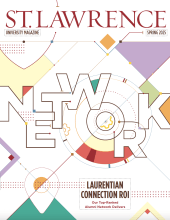
St. Lawrence Community Mobilizes to Help Injured Raptors Soar Again
At the VCA North Country Animal Hospital in Watertown, a bald eagle thrashed in its cage, its piercing gaze sharp enough to send shivers down anyone’s spine. But Debra Mousaw, St. Lawrence University’s director of human resources, stood unfazed.
“I named him Larry,” she said with a smile, unbothered by the raptor’s flapping wings and sharp talons. “I’ve wanted to see a bald eagle up close my whole life. When this opportunity came up, I jumped on it.”
The eagle had a broken pelvis, likely caused by a car collision. It needed to be transported to the Janet Swanson Wildlife Hospital in Ithaca for specialized care. That’s where Susan Willson, associate professor of biology at St. Lawrence and a leading expert in avian ecology, came in.
When the animal hospital contacted her, Willson immediately turned to SLUBAY, the University’s faculty and staff listserv which has become a resource for everything from buying and selling used furniture to connecting conservation-minded community members.
“SLUBAY is invaluable for things like this,” said Willson. “I can ask, ‘Who’s going to Ithaca?’ and I always get responses. SLU people genuinely care and step up when it’s needed.”
SLU people genuinely care and step up when it’s needed."
–Associate Professor of Biology Susan Willson
This time, Mousaw was the first to answer. She’d already planned to drive to the Ithaca area that day, so the timing was perfect.
At the Watertown animal hospital, Larry had been fed frozen mice and given pain medication to prepare him for the journey. As the vet techs carefully transferred him into a pet-carrier for the ride, Mousaw knew she was about to have an unforgettable experience. “It was incredible,” she said. “To be so close to a bald eagle and help him get the care he needed—it was a dream come true.”
Larry the eagle is just one of many birds that Willson and the St. Lawrence community have worked together to save. Willson has become the go-to person in the North Country for organizing rescues of injured birds. Her work involves coordinating with local veterinarians and wildlife rehabbers to transport birds to places with the resources and expertise to treat them.

“Living in a rural area like the North Country, there aren’t many people working with birds, so I’ve sort of become the point person,” she said.
Just two weeks earlier, Chemistry Professor Samantha Glazier transported three injured raptors to Ithaca, including a bald eagle and a red-tailed hawk. In July, Vice President of Student Affairs Jon Duraj delivered an injured great horned owl to a local rehabber. And a member of St. Lawrence’s Riding Team drove an American woodcock to the same wildlife hospital where Larry was taken for treatment.
Willson said these collaborative efforts underscore the many threats birds face. “Cats kill around 4 billion birds a year, windows another 2 billion, and cars are a huge danger as well,” she explained. In addition to her rescue work, Willson has published two research papers with student collaborators examining the effectiveness of the Birdsbesafe cat collar in protecting songbirds from hunting cats.
For Mousaw, the experience with Larry the eagle was a vivid reminder of how the St. Lawrence community supports not just one another, but also the world around them. “I’m so grateful to Dr. Willson for giving me this opportunity,” she said. “Being able to help such a majestic creature was an experience I’ll never forget.”




